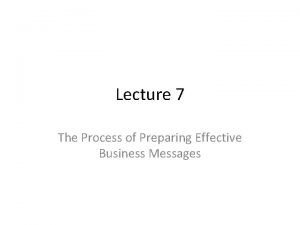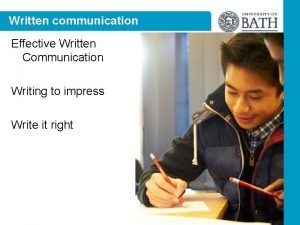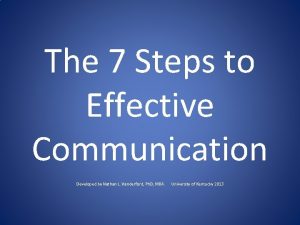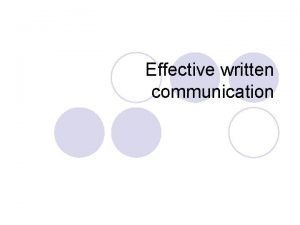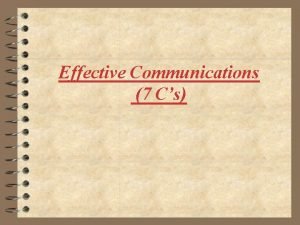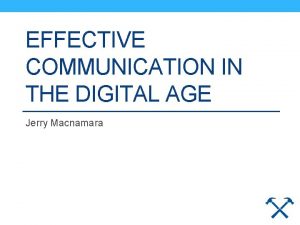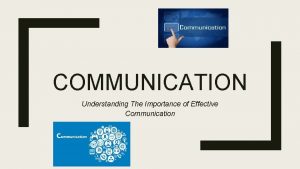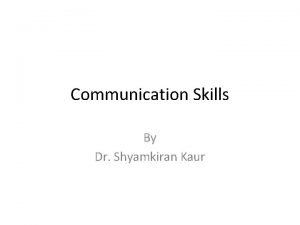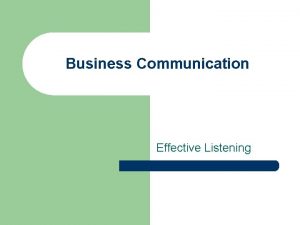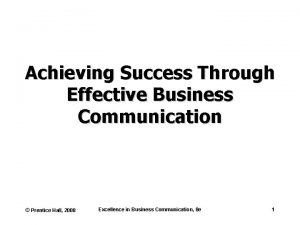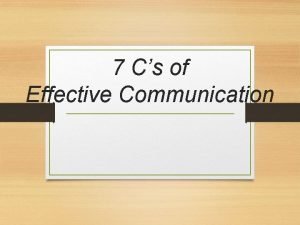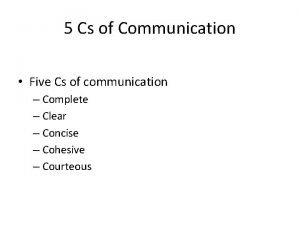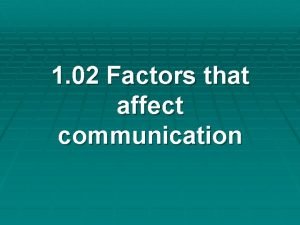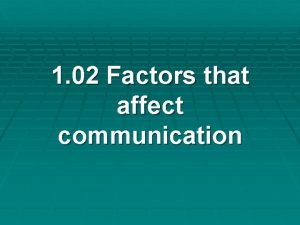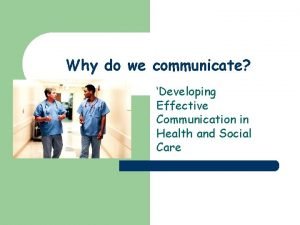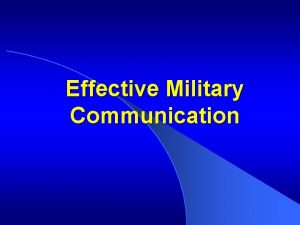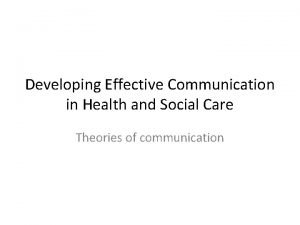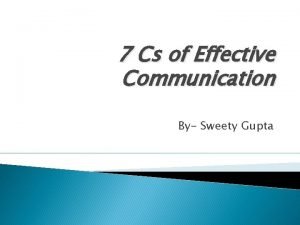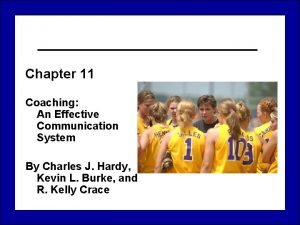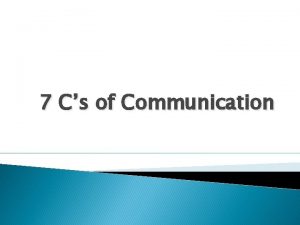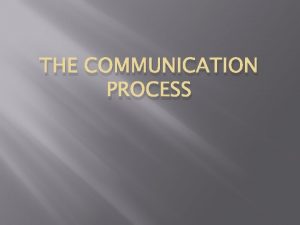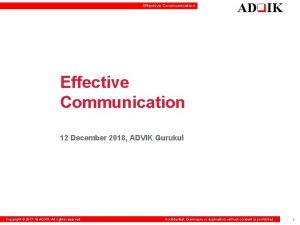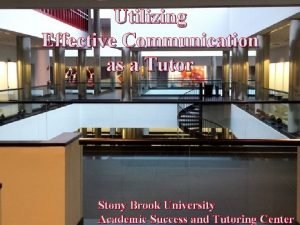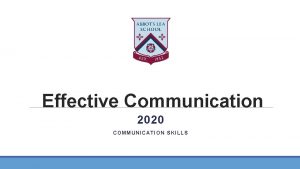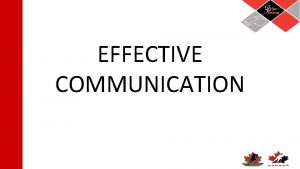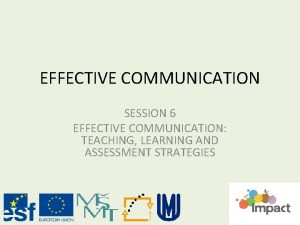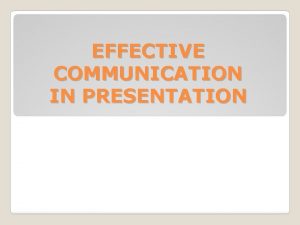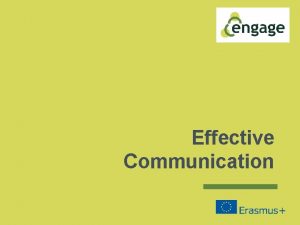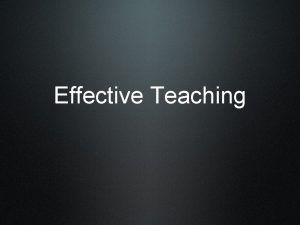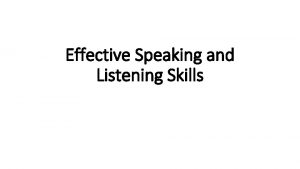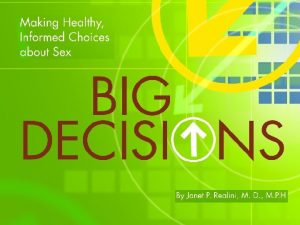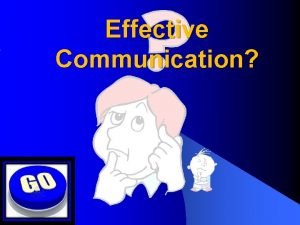EFFECTIVE COMMUNICATION COMMUNICATION Communication is a process of





















- Slides: 21

EFFECTIVE COMMUNICATION

COMMUNICATION Communication is a process of transferring information from one entity to another Or "the imparting or interchange of thoughts, opinions, or information by speech, writing, or signs".

EFFECTIVE COMMUNICATION Communication which is – Efficient – Successful – Useful – Helpful – Valuable – Of use – Effectual "The ability to communicate effectively through speaking as well as in writing is highly valued”

Different ways of communication • • Non verbal communication Visual communication Oral communication Written communication

Non verbal communication “Nonverbal communication plays a key role in every person's day to day life” Communicating through sending or receiving wordless messages Gestures Body language


Object communication Hairstyle Clothing Behavioral communication

Visual communication It is communication by presenting information through visual form. • Work on computer • Management Information system (MIS) • Presentation of reports “It refer to the actual presentation of information “ Evaluation of a good visual design is based on measuring comprehension by the audience

Oral communication It describes any type of inter-action that makes use of spoken words. “It is a vital part of the modern business world“

The types of oral communication commonly used within an organization include staff meetings personal discussions presentations telephone calls informal conversation face-to-face meetings Speeches Teleconferences videoconferences.

Issues in Oral Communication • • The Place of Pronunciation Accuracy and Fluency The Interaction Effect The Role of Listening

Written Communication It means communication by means of written symbols. (either printed or handwritten). E-mail memos proposals orders Written communication in business letters quotations forms minutes contracts

Poorly written message creates confusion and misunderstanding Thus, understanding • the purpose, • the audience, • the message • the channel is essential

Essentials in written communication 1. Composition and style v audience v Create an outline v Use AIDA -Attention-Interest-Desire-Action v Identify your main theme v Use simple language 2. Structure v reader friendly v easier to read v Adding graphs and charts

3. • • • Grammatical errors: Affect/effect Then/than Your/you're Its/it's Company’s/companies 4. Proofing • • • Proof your headers and sub headers Read the document out loud Start at the end of your document Use your finger to follow text as you read Key Point More than ever, it's important to know how to communicate your point quickly and professionally

A senior, Mr Richardson, calls Mr Smith, the work supervisor, to come to his office. When Mr Smith walks in a minute or two later, the CEO is busy with what appears to be an unexpected but very important telephone conversation. In due course, he replaces the receiver, but his mind, clearly, is still very much on what he had just heard. Hi. Mr. smith please sit down CASE 1 at the moment, we have an official lunch break lasting one hour. As from the first of next month, I want to reduce this lunch break to 30 minutes only, and bring the afternoon quitting time forward by a half-hour. No doubt, the staff will appreciate the opportunity to get home earlier. Will you please inform everyone concerned? Thanks for your time. "

Mr Richardson begins to examine some papers on his desk and waves with his hand to indicate that he has nothing further to tell the supervisor. The supervisor, in turn, opens his mouth as if starting to say something, but thinks better of it and all he utters is a weak "OK, Mr Richardson. " Mr Smith exits.

The CEO calls his supervisor into his office. He is on the telephone when Mr Smith arrives. Take a seat, won't you? I shouldn't be long. " After 15 minutes That was our landlord. He dropped quite a bombshell. They have old this building, which means we will have to be out f here in a few months. Oh, well. Maybe it's a blessing in disguise; we're rather cramped in these premises, aren't we? " …………… CASE 2

…………………. . "Hopefully, everything will work out. How are things by you? I hope no one is aggravating you too much. Now, this is why I called you: two or three people have come to me with the suggestion that we shorten the lunch break, so that everyone can knock off earlier. What do you think? " Well, personally I'd welcome the change, and I know that some of the office people would think the same way. On the other hand, many of our workers do a lot of shopping during the lunch hour at the big mall over the road. They might need a full hour for this, and after work might not be so convenient. . . Maybe I should canvass everybody and come back to you with a consensus. . We're pretty busy right now. . . Can I attend to it next week and come back to you? " "Excellent. I know there's a lot of pressure now.

Conclusion • • • Be clear Get to the point Be personnel Listen Think before you speak Be positive Establish trust Learn how to use tone & body language together Never assume anything Learn how to talk business

“Think like the wise man but communicate in the language of the people” Thank you
 Effective business message
Effective business message Objectives of written communication
Objectives of written communication 7 steps of effective communication
7 steps of effective communication The 5 inevitable laws of effective communication
The 5 inevitable laws of effective communication Factors that influences communication
Factors that influences communication Effective written communication
Effective written communication What is the importance of 7 c's of effective communication
What is the importance of 7 c's of effective communication Jerry tsai tutor
Jerry tsai tutor What does effective communication look like
What does effective communication look like Communication skills definition
Communication skills definition Ethical communication
Ethical communication Objectives of listening
Objectives of listening Achieving success through effective business communication
Achieving success through effective business communication What is the meaning of completeness in communication
What is the meaning of completeness in communication What are the 5 cs of communication
What are the 5 cs of communication Factors that affect communication
Factors that affect communication Factors that affect communication
Factors that affect communication How do people communicate
How do people communicate Effective military communication
Effective military communication Communication cycle in health and social care
Communication cycle in health and social care 7cs of effective communication
7cs of effective communication Coaching in effective communication
Coaching in effective communication
